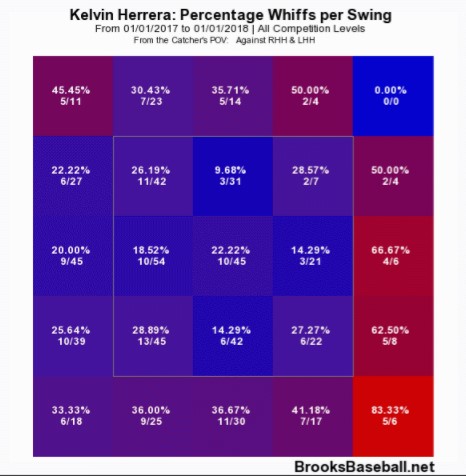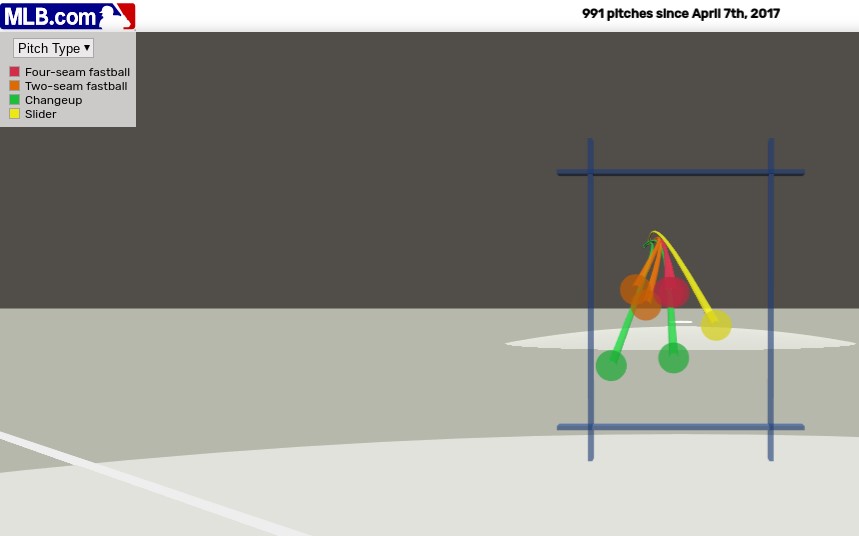| Age: | 28 |
| Bats/Throws: | R/R |
| Height/Weight: | 5'10", 200 lbs |
| Position: | Relief Pitcher |
Stars seemed aligned for Kelvin Herrera to ascend into the upper echelon of closers last year after paying his dues in set-up roles for Kansas City. Herrera made the All-Star teams in a set-up role in both 2015 and 2016 along with being the seventh inning bridge during the Royals championship run. Coming off career bests in strikeouts (86), walks (12), WHIP (0.96) and a tremendous strikeouts minus walk percentage of 26.2, Herrera’s average draft position moved into the top-100 in NFBC drafts prior to last season as the 11th reliever taken.
Then things cratered. His strand rate fell to 70 percent last season compared to a career 78 percent mark. Herrera could not retire left-handed hitters giving up a .355 weighted on-base average against them and accounting for 17 of the 20 walks he allowed. He struggled at home, less than ideal for a closer, seeing his home ERA rise to 6.09 in 34 innings pitched with a bloated .360 weighted on-base average. For the first time in his career, Herrera recorded a final ERA over four (4.25) and a WHIP of 1.348, both career worsts.
All of this adds up to a less than ideal setting for a pitcher about to enter free agency in the upcoming season. Other than former teammate Greg Holland, the reliever market moved fast and furious with closers signing fairly lucrative deals this winter. Whether health or bad luck contributed to Herrera’s rough campaign, he needs to right the ship in order to cash in this off-season. Starting with velocity, here’s his career chart courtesy of Brooks Baseball:

Since 2015, there’s been a decline in his fastball velocity. However, spring reports which track velocity suggest Herrera could be on the verge of regaining some lost speed. Last year, he averaged 97.5 MPH according to a chart by Jeff Zimmerman of Fangraphs, but so far in spring, Herrera’s hitting 98.2 MPH on average. It’s a start.
As for his arsenal, things seem to be under construction with Herrera. He’s scrapped his curve for a slider and cutter. Adding a cutter makes sense, especially given his struggles with left-handed hitters last season. While Herrera’s change generated a 44.54 whiff per swing percentage in 2016, it dropped off to 29.41 a year ago. His slider yielded a .294 batting average against and his four-seam average allowed grew to .279, contributing to his inflated BABIP’s and wOBA’s allowed.
Whether it’s the reduced velocities from last year or a less aggressive nature, Herrera’s zone charts reveal less of tendency to pitch up in the zone. First, here’s his chart from last year using whiffs per swing as the identifier:

Here’s his same chart from 2016, which Herrera achieved the highest strikeout totals of his career along with only giving up 12 walks:

By working above the strike zone, Herrera unlocked the bottom of the zone to produce strikeouts. It’s not known if the league adjusted to Herrera or a lack of trust in his stuff created last year’s less than optimal results. For an idea of how his pitches look as a hitter, here’s his 3-D chart from Baseball Savant (Statcast):

Now, this visual does not represent every pitch Herrera’s thrown, but it does exemplify he lived in the zone, often. There’s no real noticeable drop in his chase rate (swings and misses at pitches outside the strike zone) over the last two years. In fact, it remained relatively stable. It’s within the almost four point percentage drop in swinging strike percentage and over seven percent growth in contact allowed when comparing 2016 to last year. Some exists as regression to the mean, but some could be bad luck.
Overall, Herrera did not turn in a strong season which depresses his price in this year’s drafts. Sprinkle in a hard hit percentage spike to the numbers above and seeing owner’s trepidation makes sense. Even delving into his xSTATS, Herrera’s bbFIP (batted ball fielding independent pitching) shows a 4.11 versus 3.65 the year prior. But, hope lies in the expected average against of .248 and .286 xBABIP. Herrera recorded a lower exit velocity of balls in play (88.2 MPH) than he did in 2016 (89.3 MPH).
Basing a bounce back on better velocity can be risky. However, where Herrera’s being drafted, there’s no sure things. Simple regression to the mean of his career slash versus left-handed hitters of .230/.306/.357 and his career 2.98 ERA at home with only a .284 weighted on-base average. For his career, Herrera’s allowed more walks on the road than at home, which did not occur during last year’s collapse.
Migration to the mean cannot be assured, but with health and velocity, it’s a much better gamble. His projections do not seem encouraging due to last year’s results with ERA’s ranging from 3.76-to-3.90 in spite of his career ERA below three. Commanding the cutter and regaining velocity will go a long way towards a much needed bounce back in a walk year towards free agency. Ebbing back towards his career .241 batting average allowed on his four-seam and .183 with the change would be great signs. Plus, if Herrera attacks the top of the strike zone in order to change hitter’s eye levels, he can outperform his peripheral projections.
Most closers come with varying levels of risk and Kelvin Herrera’s no different. Early signs suggest he will be better than last year. With a lowered price in drafts, an evolving arsenal and clear path to saves, why not take the chance on a 28-year old reliever with pedigree? Fantasy owners do not need 2016 Herrera to reemerge, they just need his results from last year to meet them in them in the middle to net a profit.
--------------------------------------------------------------------------------------------------------------------------
Statistical Credits:
Fangraphs.com, BrooksBaseball.net, BaseballSavant.com, xSTATS.org
.jpg)
